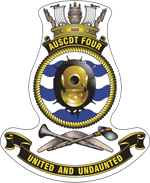Australian Clearance Diving Team Four

Australian Clearance Diving Team Four (AUSCDT FOUR) is one of two commissioned Clearance Diving Teams in the Royal Australian Navy. They are the Australian Defence Force’s specialist divers, who operate in-service diving equipment to the maximum permissible depths. They also conduct explosive ordnance disposal for the Navy, and are capable of locating and destroying or recovering underwater ordnance or maritime assets.
The Australian Clearance Diving Branch was created in 1951 and for many years much of its activities were based on the east coast of Australia. Then, in 1962, a Reserve Diving Team was formed at HMAS Leeuwin in Fremantle. Eventually this unit was absorbed into Australian Clearance Diving Team Four when it was established as an operational unit at HMAS Stirling in 1978.
AUSCDT FOUR has always been at the forefront of operational activity. Between 1980-1985, it provided personnel to the counter-terrorist squadron of the Special Air Service Regiment. Team personnel also formed the bulk of the specially-formed Clearance Diving Team which served in the 1991 Gulf War. Team members also deployed to East Timor as part of the International Force East Timor (INTERFET) in 1999. On 1 December 2001, Australian Clearance Diving Team Four became a commissioned unit of the Royal Australian Navy.
The Team consists of a headquarters element and three operational elements which specialise in tactical operations, mine countermeasures and battle damage repair. All elements are capable of performing explosives disposal and can be deployed independently or as a combined task unit. The Team operates specialised diving and explosive ordnance disposal equipment and can be deployed independently or as a combined task unit. This equipment enables the Team to locate and dispose of modern mines that feature sophisticated arming and targeting systems. AUSCDT FOUR personnel are also trained in field craft and the use of wide range of small arms, enabling them to deploy to remote operating areas under varying levels of threat.


